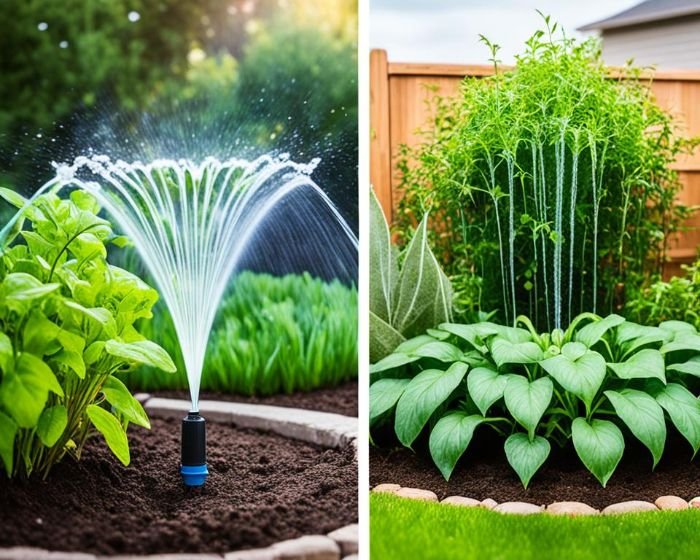Do you want a garden that thrives but struggle with watering it right? We’ve got you covered! This article will explore drip and sprinkler irrigation systems. We’ll show you how to keep your plants healthy while saving water.
As a gardener, you know how crucial watering is for your plants’ health and growth. A good irrigation system can change everything. It helps with plant health, makes maintenance easy, and saves water.
But, which system is best? Is the old sprinkler system still top-notch, or does drip irrigation beat it? Let’s dive into these options and help you pick the right one for your garden.
Key Takeaways:
- Drip irrigation and sprinkler irrigation are two popular options for garden irrigation systems.
- Efficient irrigation is crucial for plant health and water conservation.
- Understanding the benefits and drawbacks of each system can aid in choosing the right one for your garden.
- Factors such as garden type, water usage, and maintenance preferences influence the suitability of drip and sprinkler systems.
- Expert recommendations and case studies will provide valuable insights to help facilitate your decision.
Table of Contents
Introduction to Garden Irrigation Systems
Having a good garden irrigation system is key for keeping plants healthy and making landscapes look great. It helps save water and cuts down on the work needed to keep things green. We’ll look into why efficient watering is important and talk about the main types of systems: drip and sprinkler.
Importance of Efficient Irrigation
Efficient watering is vital for saving water and cutting down on waste. It makes sure plants get just the right amount of water. This stops too much or too little water from causing problems like root rot and diseases.
Overview of Drip and Sprinkler Systems
There are two main types of garden irrigation: drip and sprinkler systems. Each has its own benefits and fits different gardens and watering needs.
Drip irrigation systems send water right to the roots, cutting down on evaporation and weeds. They use tubes and emitters to slowly release water into the soil. This helps plants grow deep roots and absorb water better. Drip systems are great for saving water and work well in gardens with lots of plants, containers, or where water is limited.
Sprinkler irrigation systems spray water over a big area. They’re good for big gardens or lawns that need even watering. You can adjust sprinklers to give plants the right amount of water. They’re often used for grassy areas like lawns or sports fields and can be set to water automatically.
We’ve seen why efficient watering is key and looked at the main types of systems. Next, we’ll go into more detail about each system.
Understanding Drip Irrigation
We will look into drip irrigation, a top way to water plants that saves water and waters precisely. It uses drip emitters and tubing to send water right to the roots, cutting down on waste and making sure water gets where it’s needed.
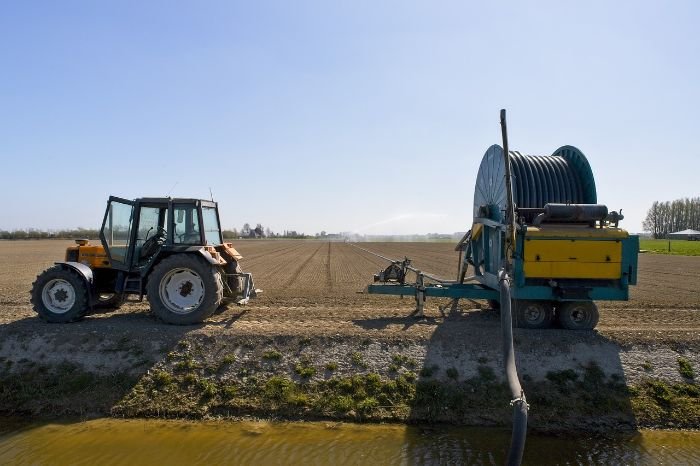
How Drip Irrigation Works
Drip irrigation sends water slowly and steadily to plants through tubing. Small emitters at each plant’s base let water drip onto the soil.
This way, it stops water from running off or evaporating. The steady flow gets to the roots, helping plants grow strong and saving water.
Installation Process for Drip Systems
Setting up drip irrigation takes a few steps. First, tubing is laid out to reach each plant. Then, emitters are put on the tubing, close to each plant’s base.
These emitters can be set to water different plants in different amounts. It’s also key to think about the water source and pressure needs for the system. You might need a filter and pressure regulator to keep the system working well.
Benefits of Drip Irrigation
Drip irrigation has many advantages for gardeners:
- Water Efficiency – It’s very efficient, sending water right to the roots. This cuts down on runoff and evaporation.
- Precise Watering – It waters plants just the right amount, preventing overwatering. This helps plants grow well and saves water.
- Flexibility – You can adjust the system for different plants. Change the flow rate and emitter placement as needed.
- Reduced Weed Growth – Water goes straight to the roots, leaving the soil surface dry. This stops weeds from growing.
- Improved Plant Health – The controlled watering helps roots grow strong and lowers the chance of diseases from too much water.
Suitability for Different Garden Types
Drip irrigation works well in many gardens, like:
- Vegetable gardens
- Flower beds
- Container gardens
- Orchards
- Landscape gardens
It’s great for small gardens or big farms. Drip irrigation is an efficient and green way to water your plants.
Exploring Sprinkler Irrigation
How Sprinkler Systems Work
A sprinkler irrigation system is a great way to water gardens and lawns. It uses underground pipes to send water to spray heads or rotor heads. These heads spray water out in a controlled way, covering the areas evenly.
Installation Process for Sprinkler Systems
Installing a sprinkler system takes some work but is worth it. First, you map out the garden to figure out where to put the spray heads and rotor heads. Then, you set up irrigation zones based on the plants, sun, and soil.
After that, you dig trenches for the pipes and put in the fittings. Connect the pipes to a water source and control it with a timer or controller. Finally, test the system to make sure it works right.
Benefits of Sprinkler Irrigation
Sprinkler irrigation has many benefits for gardeners. It makes sure water is spread evenly, helping plants grow strong and landscapes look great. You can adjust the heads to water exactly where needed, avoiding waste.
It’s also great for all garden sizes, from small gardens to big lawns. You can set up different zones for different plants, making it flexible. This way, you can water your garden just right.
Suitability for Different Garden Types
Sprinkler systems work well in many gardens. They’re perfect for lawns, big landscapes, and gardens with lots of plants. You can set up zones to water different plants in the same system.
They’re also good for gardens with little water. The heads can be adjusted to use water wisely, saving it and helping with conservation.
Comparing Drip and Sprinkler Systems
Choosing the right irrigation system for your garden is key. We’ll look at drip and sprinkler systems. We’ll talk about their efficiency, cost, maintenance, customization, and how they affect plant health.
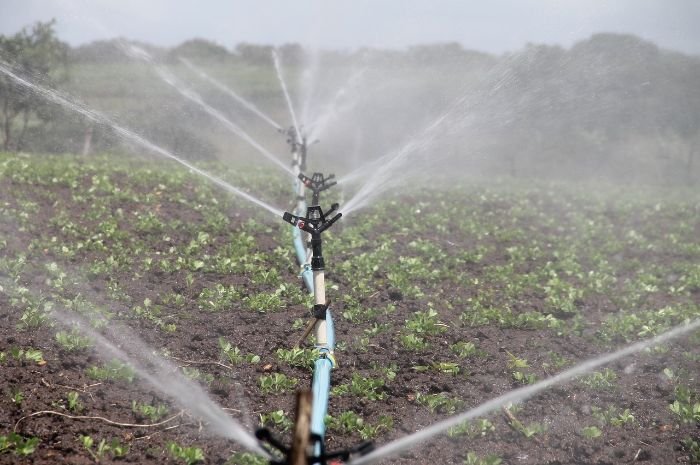
Efficiency and Water Conservation
Efficiency and saving water are big factors when picking an irrigation system. Drip systems are super efficient. They send water right to the roots, cutting down on evaporation and waste. Sprinklers might lose more water because they cover a bigger area and can lead to evaporation.
Cost and Maintenance
Cost and upkeep are also big deals. Drip systems cost more at first because you need special parts like emitters and tubing. But, they save money over time by using less water and helping plants stay healthy. Sprinklers are cheaper upfront but need more work to keep them running right, like fixing heads and leaks.
Customization and Flexibility
Being able to customize and adjust your system is important. Drip systems let you fine-tune watering for each plant’s needs. They’re great for gardens with different plants and needs. Sprinklers work well for big areas like lawns and are easy to set up.
Impact on Plant Health
The type of irrigation system affects your plants’ health. Drip systems water the roots directly, lowering the chance of leaf diseases. This means healthier plants with fewer problems. Sprinklers cool plants in the heat but can cause fungal diseases if plants stay wet too long.
Looking at these factors helps you decide between drip and sprinkler systems. Think about your garden’s size, layout, and your goals for saving water. This way, you can pick the best system for your garden.
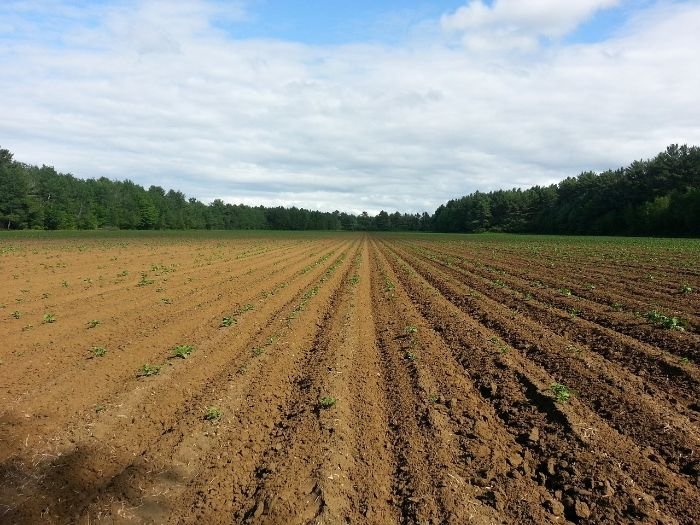
Choosing the Right System for Your Garden
Choosing the right system to water your garden is key for healthy plants and saving water. Drip irrigation and sprinkler systems both water your garden. But they work differently for different gardens. Think about these points to decide:
Factors to Consider
- Garden Size – Know how big your garden is. This affects what irrigation system you pick. Big gardens do well with sprinklers that cover a lot of ground. Smaller gardens are better with drip irrigation, which saves water.
- Plant Types – Different plants need different amounts of water. Think about what your plants need for moisture and roots. This ensures they get enough water without wasting it.
- Water Availability – Check how much water you have and where it comes from. This helps pick a system that saves water.
- System Maintenance – Think about how much upkeep each system needs. Drip irrigation uses less maintenance because it waters plants directly. Sprinklers need regular checks for clogs or broken parts.
Expert Recommendations
Getting advice from experts can be really helpful. They know about the latest in irrigation and what works best for gardens. Experts can guide you to make smart choices based on their experience.
Think about the factors mentioned, look at real examples, and get expert advice. This way, you can pick the best irrigation system for your garden. The right system means better water use, healthier plants, and a sustainable garden.
Integrating with Other Gardening Techniques
Irrigation systems can make gardens better by working with other gardening methods. We will look at how they work with hydroponic, biodynamic, and vertical gardens. Let’s see how these combinations help gardens grow better.
Using Irrigation with Hydroponic Gardens
Hydroponic gardening grows plants in a nutrient-rich water solution, not soil. Adding irrigation to hydroponics lets gardeners control water and nutrients well. Drip irrigation is great for hydroponics because it waters plants slowly and evenly. This stops water from pooling and helps plants grow strong.
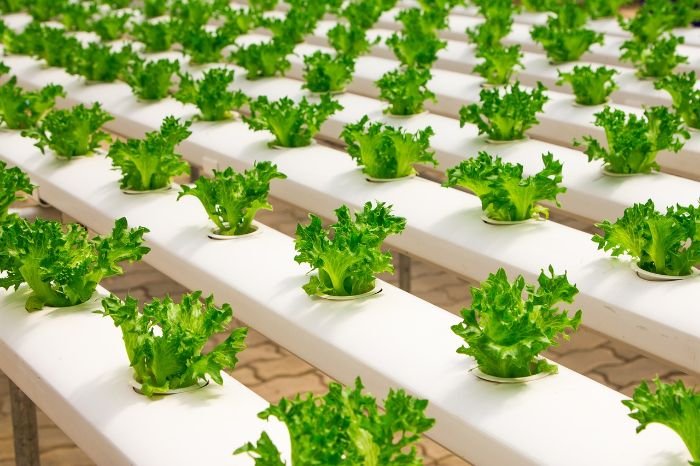
It also makes sure plants in hydroponics get the right amount of nutrients. This leads to more and better crops.
Combining with Biodynamic Gardening Practices
Biodynamic gardening looks at how soil, plants, animals, and the stars work together. Using irrigation with biodynamic gardening helps plants get water when they need it. Drip irrigation is good for this because it waters plants right at their roots.
This mix of irrigation and biodynamic gardening makes growing plants more balanced and sustainable.
Enhancing Vertical Gardens with Proper Irrigation
Vertical gardens use walls or structures to grow plants in a small space. They need good irrigation to work well. Techniques like micro-sprinklers or drip systems spread water evenly across the garden.
This makes sure every plant gets enough water. Using irrigation with vertical gardens saves water and helps plants grow well in these spaces.
Troubleshooting Common Issues
To keep your garden’s irrigation system working well, you need to fix common problems. This part will help you find and fix leaks, solve uneven water issues, and adjust for the seasons.
Identifying and Fixing Leaks
It’s key to find leaks to save water and protect your garden. Look for wet spots, low water pressure, and high water bills. Check your system for leaks and listen for strange sounds. You can also use special devices or get help from experts to find hidden leaks.
Addressing Uneven Water Distribution
Some areas might get too much water, while others get too little. This can harm your plants. Check your sprinklers and emitters for blockages or misplacement. Clean or fix them if needed. Use devices to control water flow and make sure all areas get the right amount.
Seasonal Adjustments and Maintenance Tips
Adjusting your irrigation system with the seasons is crucial. Change the watering schedule based on weather, plants’ needs, and how fast water evaporates. Clean filters, replace old parts, and remove blockages regularly to keep your system running smoothly.
Conclusion
Choosing the right garden irrigation system is key for water efficiency and plant health. We looked at drip and sprinkler systems in this article. We talked about their functions, how to install them, and their benefits.
When picking a system, think about your garden’s needs. Consider the size, types of plants, and how much water you have. Drip systems work great for areas with low water pressure and send water right to the roots. Sprinkler systems are better for big areas and spread water evenly.
Using a garden irrigation system has many perks. It saves water by reducing evaporation and runoff. It also lets you set watering schedules that help plants grow better. Plus, it makes taking care of your garden easier by automating watering, which saves time.
In conclusion, the right garden irrigation system changes how you care for your garden. It uses water wisely, helps plants stay healthy, and makes garden care easier. By picking the right system for your garden, you can have a beautiful outdoor space for many years.
FAQ
What is a garden irrigation system?
A garden irrigation system delivers water to plants in a controlled way. It makes sure plants get the right amount of water regularly. This helps plants grow well and saves water.
What are the different types of irrigation systems available?
There are two main types: drip and sprinkler irrigation. Drip irrigation sends water right to the roots. Sprinkler irrigation waters a bigger area with sprinklers.
How does drip irrigation work?
Drip irrigation slowly waters plants through tubes and emitters at their roots. It’s efficient because it cuts down on evaporation and runoff.
How is a drip irrigation system installed?
Installing a drip system means putting emitters at each plant’s base. You arrange the tubing to water the right spots. Getting it right is key for good watering.
What are the benefits of drip irrigation?
Drip irrigation saves water and waters plants just right. It helps control weeds. It’s great for gardens with many types of plants, each needing different water.
What are the benefits of sprinkler irrigation?
Sprinkler systems spread water evenly and are easy to set up. They work well for big gardens with similar water needs.
What are the differences between drip and sprinkler systems?
Drip and sprinkler systems vary in efficiency and water use. Drip is better for saving water and caring for plants. Sprinklers are good for big areas and uniform watering.
How can I troubleshoot common issues related to irrigation systems?
Fix leaks and uneven watering by checking and fixing problems. Regular upkeep, like looking for clogs, keeps the system working well.






